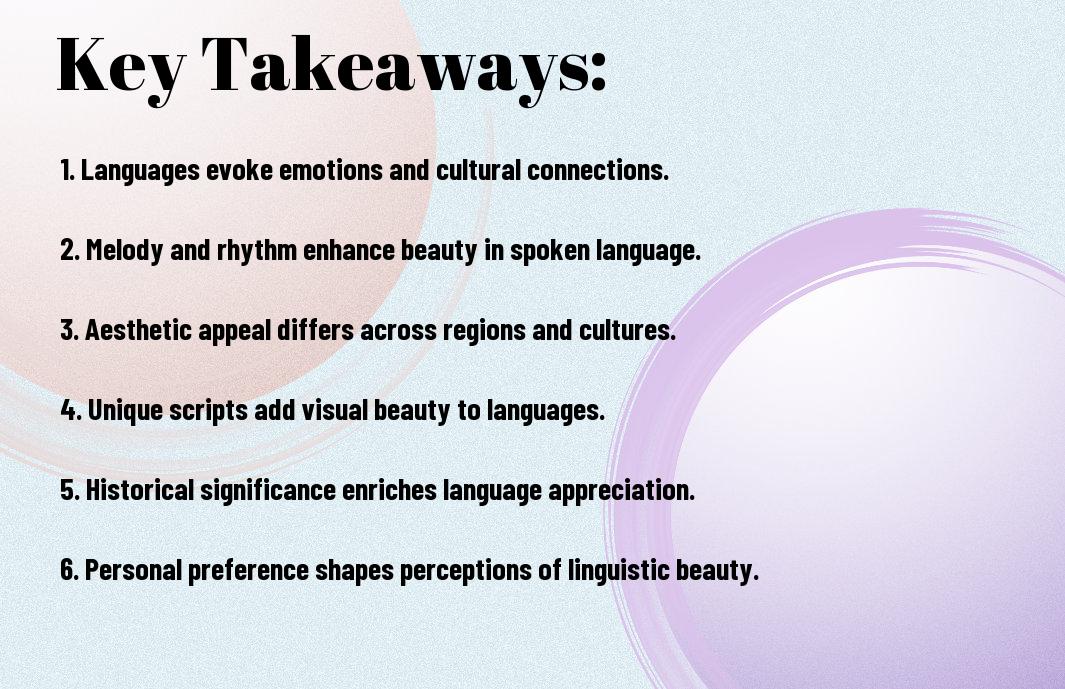As you wander through the labyrinth of human communication, you may find yourself enchanted by the melodic sounds and poetic rhythms of certain languages. Your ears may perk up at the sound of a softly spoken phrase, and your heart may skip a beat at the beauty of a well-crafted sentence. In this exploration, you will begin on a journey to discover the languages that are often regarded as the most beautiful, and you will find that the concept of beauty is as subjective as it is captivating.
Key Takeaways:
- The melody and phonetics of a language play a significant role in determining its beauty, with languages like Italian and Spanish being known for their musical quality.
- Cultural and historical context can greatly influence the perception of a language’s beauty, with languages like Arabic and Chinese being highly valued for their rich cultural heritage.
- Linguistic diversity and complexity can also contribute to a language’s beauty, with languages like Japanese and Korean having unique grammatical structures and writing systems.
- The sound and rhythm of a language can be highly subjective, with different people finding different languages beautiful based on their personal preferences and experiences.
- Ultimately, the beauty of a language is a matter of personal taste and can vary greatly from person to person, making it a fascinating and multifaceted topic to explore.

Sonic Beauty
For you, the sound of a language can be a powerful trigger, evoking emotions and memories that linger long after the words have faded away. As you listen to the melodic rhythms and cadences of different languages, you may find yourself drawn to certain sounds and accents that resonate with your own sense of beauty and harmony.
The Music of Italian
Beneath the surface of Italian lies a rich tapestry of sound, with its soft consonants and melodic vowels weaving a sonic spell that is hard to resist. As you listen to the musicality of Italian, you may find yourself enchanted by the way the words seem to sing and dance on the tongue.
The Cadence of Spanish
Around the world, you may have noticed the distinctive cadence of Spanish, with its rising and falling intonations that give the language a unique sense of passion and expressiveness. As you listen to the rhythmic flow of Spanish, you may find yourself swept up in the emotional tide of the language.
For instance, as you immerse yourself in the sounds and rhythms of Spanish, you may begin to appreciate the way the language seems to embody the fiery spirit of its native speakers, with its sharp consonants and melodic vowels conveying a sense of energy and vitality that is hard to match. As you listen to the cadence of Spanish, you may find yourself drawn into a world of passion and beauty, where the sounds and rhythms of the language seem to come alive in your very being.

Structural Elegance
One of the key aspects that makes a language beautiful is its structural elegance, which can evoke a sense of wonder in you as you research deeper into its intricacies, and you begin to appreciate the unique characteristics that set it apart from other languages.
The Grammar of Arabic
Prior to exploring the vast array of languages, you will find that the grammar of Arabic, with its complex system of consonants and vowels, presents a fascinating case, as you notice the way it weaves together to form a rich tapestry of sound and meaning that is distinctly its own.
The Syntax of Japanese
Elegant in its simplicity, the syntax of Japanese offers you a glimpse into a world where the placement of words can dramatically alter the meaning of a sentence, and you start to see the beauty in the subtle nuances of this language.
Considering the syntax of Japanese, you will discover that it is a language that values context and implication, often relying on the listener’s ability to infer meaning from the situation, and as you explore this language further, you will find that its unique blend of simplicity and complexity makes it a truly beautiful language to explore and understand.
Expressive Depth
Many languages boast a profound ability to convey complex emotions and ideas, drawing you into a world of nuanced expression. As you examine into the rhythms and cadences of these languages, you begin to appreciate the richness they bring to your understanding of the human experience.
The Idioms of French
Fascinatingly, French idioms often rely on poetic metaphors, allowing you to grasp the subtle shades of meaning that underlie everyday conversations, and inviting you to explore the cultural heritage that shapes your perception of the world.
The Nuances of Portuguese
Authentically, an appreciation for the melodic intonations of Portuguese can transport you to a realm of sonic beauty, where your senses are heightened and your emotional response is deeply felt, as you begin to unravel the intricate web of meanings that underlie this captivating language.
Idioms in Portuguese, as you will discover, are often imbued with a unique blend of passion and lyricism, enabling you to tap into the very essence of the culture, and to experience the full depth of your own emotional landscape, as you navigate the twists and turns of this expressive language.
Cultural Significance
Unlike other aspects of language, cultural significance is deeply personal, and you may find yourself drawn to a language for reasons that are unique to your experiences. As you explore the world of languages, you can visit what are the top ten most beautiful languages to discover the diversity of opinions on this topic.
The History of Mandarin
With the complexity of Chinese characters, you will find that Mandarin has a rich history that spans thousands of years, influencing your perception of its beauty and significance.
The Symbolism of Russian
For you, the Cyrillic alphabet may evoke a sense of mystery, and as you explore deeper, you will discover the intricate symbolism woven into the language, reflecting your own associations with Russian culture.
Symbolism in Russian is multifaceted, and as you explore its nuances, you will uncover the ways in which it resonates with your own emotional and aesthetic responses, drawing you into a world of depth and meaning that is uniquely your own, shaping your appreciation for the language’s beauty and significance.
Phonetic Appeal
Now, as you investigate into the world of languages, you’ll find that some have a certain melodic quality that sets them apart. The way words sound can be just as beautiful as the way they look on paper. Your ears will pick up on the rhythm and cadence of a language, and some will undoubtedly strike a chord with you.
The Sounds of Swedish
Beneath the surface of Swedish lies a treasure trove of sounds that will enchant your senses. You’ll discover a language that sings with a gentle lilt, its words tumbling out in a smooth, musical flow that’s a joy to listen to.
The Intonations of Greek
Among the languages that boast a rich phonetic heritage, Greek stands out for its distinctive intonations. You’ll notice how the pitch and stress of words convey meaning and emotion, drawing you into a world of expressive nuance.
But as you explore the intonations of Greek further, you’ll begin to appreciate the subtlety and complexity that underlies this beautiful language. You’ll find that the rise and fall of pitch, the emphasis on certain syllables, all combine to create a sense of drama and passion that’s hard to resist, and you’ll be swept up in the expressive power of Greek.
Linguistic Diversity
After exploring the world’s languages, you’ll discover a rich tapestry of sounds, structures, and expressions. Your journey will take you through a kaleidoscope of dialects, each with its unique character and beauty.
The Variations of English
For instance, as you probe into the English language, you’ll find a plethora of variations, from the Queen’s English to American slang, each with its own rhythm and cadence, shaping your perception of the world.
The Dialects of German
Between the standard German and its dialects, you’ll notice a fascinating spectrum of differences, with regional accents and vocabulary that reflect the country’s history and culture, inviting you to explore and appreciate its nuances.
Diversity is what makes the dialects of German so compelling, as you’ll encounter a wide range of expressions, from the melodic sound of Bavarian to the guttural tone of Hamburgisch, each one a testament to the language’s adaptability and your ability to connect with its speakers.
Final Words
Conclusively, as you ponder the melodic sounds and linguistic nuances, you’ll find that the most beautiful languages in the world are a matter of personal preference. You can explore more about the harmony of languages at And the most beautiful languages in the world are… ‹ GO Blog, and perhaps, you’ll discover the one that resonates with your soul, leaving an indelible mark on your perception of beauty.
FAQ
Q: What makes a language considered one of the most beautiful in the world?
A: A language can be considered one of the most beautiful in the world due to various factors such as its melodic sound, grammatical complexity, and cultural significance. For instance, languages like Italian and Spanish are often praised for their musicality and expressive nature, while languages like Arabic and Chinese are admired for their unique writing systems and historical importance. The beauty of a language is subjective, but it is often characterized by its ability to evoke emotions, convey complex ideas, and connect people across cultures.
Q: Which languages are commonly regarded as the most beautiful in the world?
A: There are several languages that are frequently considered to be among the most beautiful in the world, including French, known for its romantic connotations and poetic sound; Japanese, admired for its unique blend of simplicity and complexity; and Portuguese, praised for its melodic rhythm and expressive intonation. Other languages, such as Russian, Hindi, and Swedish, are also often cited as being particularly beautiful due to their distinctive grammatical structures, phonetic sounds, and cultural associations. Ultimately, the perception of a language’s beauty depends on personal taste and cultural context.
Q: Can learning a beautiful language have any benefits beyond its aesthetic appeal?
A: Yes, learning a language considered to be one of the most beautiful in the world can have numerous benefits beyond its aesthetic appeal. For example, learning a new language can improve cognitive abilities, enhance career opportunities, and broaden cultural understanding. Additionally, studying a language like Mandarin Chinese or Arabic can provide access to a vast array of literary and cultural works, while learning a language like French or Italian can facilitate travel and communication in diverse regions. Moreover, the process of learning a language can be a rewarding and enriching experience in itself, allowing individuals to develop new skills, challenge themselves, and connect with others who share similar interests and passions.

